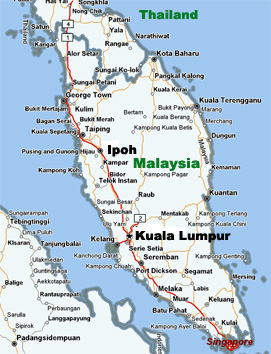

| Malaysia is one of the most pleasant, hassle-free countries to visit in southeast Asia. It's buoyant and wealthy, and has moved towards a pluralist culture based on a vibrant and interesting fusion of Malay, Chinese, Indian and indigenous cultures and customs. Most visitors to Malaysia stick to the insane headlong rush of Kuala Lumpur, the colonially soothing Cameron Highlands Hill Station or the hedonistic torpor of Langkawi. However, the island of East Malaysia offers spectacular wildlife, longhouses and the awe-inspiring Mt Kinabalu. Malaysia's love of Western-style industrialisation is abundantly clear in its big cities. Aside from the gleaming glass of the 21st Century, though, Malaysia boasts some of the most superb beaches, mountains and national parks in Asia. |
 |
||||||||||||||||||||||||||||||||||||||||||||||||||||||||||||||||||||||||||||||||||||||||||||||||||||||||||||||
| Full country name: Federation of Malaysia Area: 329,750 sq km Population: 23 million Capital City: Kuala Lumpur People: 50% Malay, 33% Chinese, 9% Indian, plus indigenous tribes such as Orang Asli and Iban Language: English, Tamil, Chinese, Malay Religion: 52% Muslim, 17% Buddhist, 12% Taoist, 8% Christian, 8% Hindu, 2% tribal Government: constitutional monarchy Head of State: Yang di-pertuan agong (King) Tuanku Syed Sirajuddin Syed Putra Jamalullail Head of Government: Prime Minister Abdullah bin Ahmad Badawi GDP: US$99 billion GDP per capita: US$4,530 Annual Growth: 2% Inflation: 4% Major Industries: Tin, rubber, palm oil, timber, oil, textiles, electronics Major Trading Partners: Singapore, Japan, USA |
|||||||||||||||||||||||||||||||||||||||||||||||||||||||||||||||||||||||||||||||||||||||||||||||||||||||||||||||
| History Aboriginal Malays (Orang Asli) began moving down the Malay peninsula from southwestern China about 10,000 years ago. The peninsula came under the rule of the Cambodian-based Funan, the Sumatran-based Srivijaya and the Java-based Majapahit empires, before the Chinese arrived in Melaka in 1405. Islam arrived in Melaka at about the same time and spread rapidly. Melaka's wealth soon attracted European powers, and the Portuguese took control in 1511, followed by the Dutch in 1641. The British established a thriving port in Penang in 1786 and took over Melaka in 1795. The British traded for spices and colonised the interior of the peninsula when tin was discovered. East Malaysia came into British hands via the adventurer Sir James Brooke (who was made Rajah of Sarawak in 1841 after suppressing a revolt against the Sultan of Brunei) and the North Borneo Company (which administered Sabah from 1882). Gradually, the Federated Malay States were created in piecemeal fashion over the course of the 19th century. The final pieces of the Malaysian mosaic fell into place when Britain took formal control of both Sabah and Sarawak after WWII. The indigenous labour supply was insufficient for the needs of the developing rubber and tin industries, so the British brought large numbers of Indians into the country, altering the peninsula's racial mix. The Japanese overran Malaya in WWII. Communist guerrillas who fought the Japanese throughout the occupation began an armed struggle against British rule in 1948 and Malaya achieved independence in 1957. Sabah, Sarawak and Singapore combined with Malaya to establish Malaysia in 1963, but two years later Singapore withdrew from the confederation. The formation of Malaysia was opposed by both the Philippines and Indonesia, as each had territorial claims on East Malaysia. Tension rose in 1963 during the 'Confrontation' with Indonesia. Indonesian troops crossed Malaysia's borders but were repelled by Malaysian and Commonwealth forces. In 1969, violent riots broke out between Malays and Chinese, though the country's racial groups have since lived in relative peace together. The United Malays National Organisation (UMNO) has been in power since 1974. Prime Minister Dr Mahathir Mohamad, who is keen to exert his influence on the world stage as a pan-Asian leader, presided over a booming economy until 1997, when tumbling Asian currencies dragged the ringgit down with them. In September 1998 the country hosted the Commonwealth Games, but the public relations aspect of the competition came apart when students and citizens protested against the unfair sacking and later imprisonment of deputy Prime Minister, Anwar Ibrahim. Continuing street protests calling for the resignation of Dr Mahatir Mohamad have unsettled Malayasia's reputation as one of the most politically stable of southeast Asian countries. By the time the 21st century rolled around, social upheavals had faded to a distant rumble and the Malaysian economy had clawed its way back into the black. Dr Mahathir Mohamad remained a controversial figure until the end. Just before his resignation in October 2003, after 20 years at the helm, the PM addressed a meeting of Islamic countries hosted by Malaysia, and exhorted them to collectivise against an alleged world Jewish conspiracy. His replacement, Abdullah Ahmad Badawi, won a March 2004 election in a landslide. In August 2004 the country's highest court upheld Anwar Ibrahim's appeal against his sentence and he was released from jail. |
|||||||||||||||||||||||||||||||||||||||||||||||||||||||||||||||||||||||||||||||||||||||||||||||||||||||||||||||
| Livestock
Malaysia with a total population of about 22 M people imported food items worth 9.2 billion Ringgits including vegetables, fruit, meat, dairy products, fish and animal feedstuffs in 1996. Imports reached 10.4 billion Ringgits in 1997. Approximately 2.5 billion Ringgits of this were for livestock products including 70-75% for poultry, 20-25% for swine and 1-2% for ruminants. However, Malaysia is generally self-sufficient in non-ruminant production, and some 10-20% of production is exported (although more than 85% of feed ingredients are imported to support the production of this subsector). |
|||||||||||||||||||||||||||||||||||||||||||||||||||||||||||||||||||||||||||||||||||||||||||||||||||||||||||||||
Statistics for ruminant numbers, beef, veal, buffalo meat and milk production, cattle imports and beef and veal imports for Malaysia for the period 1992-2001
|
|||||||||||||||||||||||||||||||||||||||||||||||||||||||||||||||||||||||||||||||||||||||||||||||||||||||||||||||